Abstract
We compared the in vitro antibacterial activity of DV-7751a against gram-positive and -negative bacteria with those of quinolones currently available. MICs for 90% of the strains tested (MIC90s) against clinical isolates of methicillin-susceptible and -resistant Staphylococcus aureus and Staphylococcus epidermidis were 0.20, 0.39, 0.20, and 0.78 micrograms/ml, respectively. Moreover, MIC50s for DV-7751a against ofloxacin-resistant methicillin-resistant S. aureus were 4-, 8-, 16-, 32-, and 64-fold lower than those for tosufloxacin and sparfloxacin, levofloxacin, ofloxacin and fleroxacin, ciprofloxacin, and lomefloxacin, respectively. DV-7751a inhibited the growth of all strains of Streptococcus pneumoniae, Streptococcus pyogenes, and Peptostreptococcus spp. at 0.39, 0.39, and 0.78 micrograms/ml, respectively, and was 4- to > 16-fold more active against enterococci at the MIC90 level than the other quinolones tested. The activity of DV-7751a against Pseudomonas aeruginosa was roughly comparable to those of levofloxacin and sparfloxacin at the MIC90 level and was two- to fourfold less than that of ciprofloxacin. DV-7751a showed activity comparable to those of levofloxacin and ciprofloxacin against the other glucose-nonfermenting bacteria Haemophilus influenzae, Neisseria gonorrhoeae, and Moraxella catarrhalis (MIC90s of 0.025, 0.20, and 0.10 micrograms/ml, respectively). DV-7751a activity was not affected by medium, inoculum size, or the addition of human serum but was decreased under acidic conditions and in human urine, as were the other quinolones tested. Time-kill curve studies demonstrated the rapid bactericidal action of DV-7751a against S. aureus, S. pneumoniae, Escherichia coli, and P. aeruginosa. The frequency of spontaneous resistance to DV-7751a was less than or equal to those of the reference drugs. DV-7751a inhibited the supercoiling activity of DNA gyrases from S. aureus, E. coli, and P. aeruginosa at concentrations comparable to those of levofloxacin and sparfloxacin.
Full text
PDF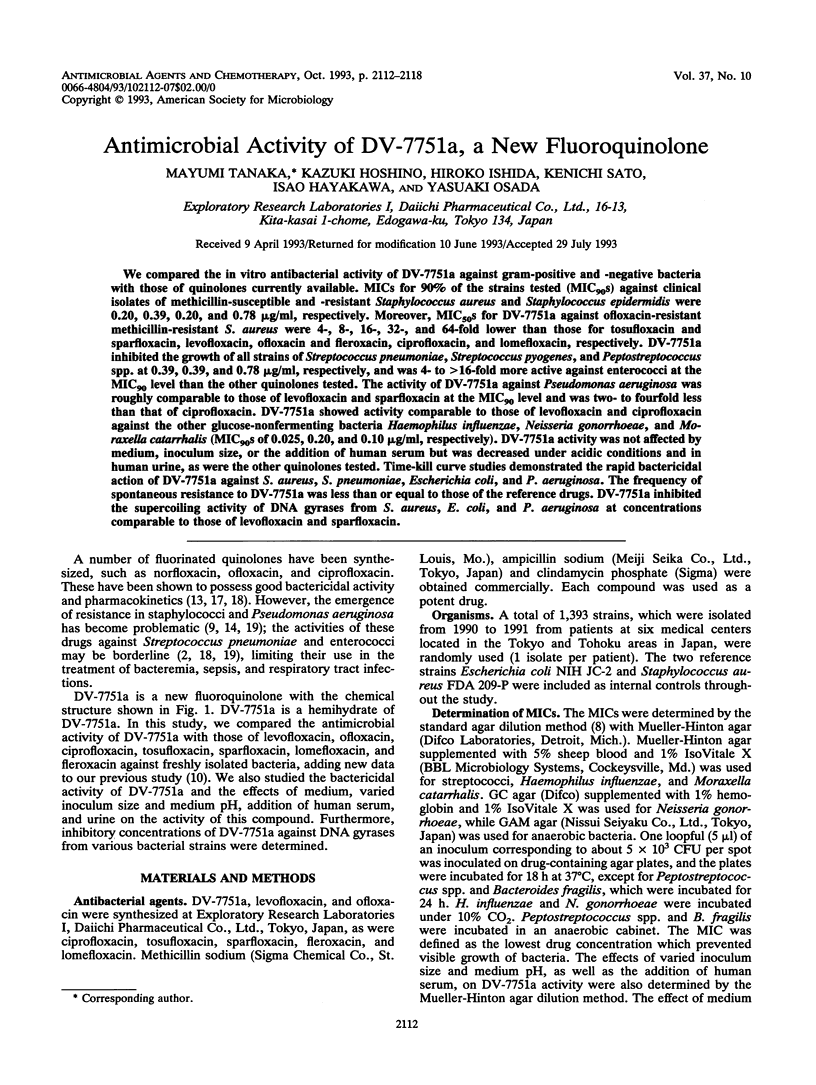
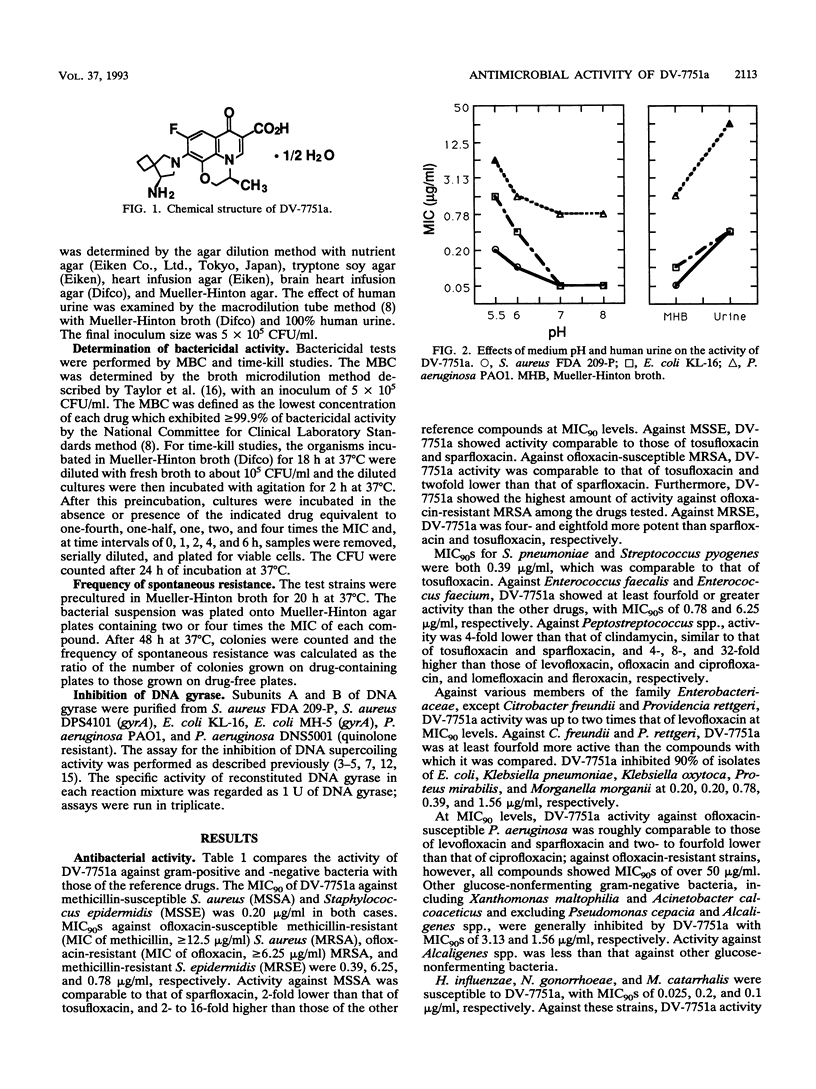
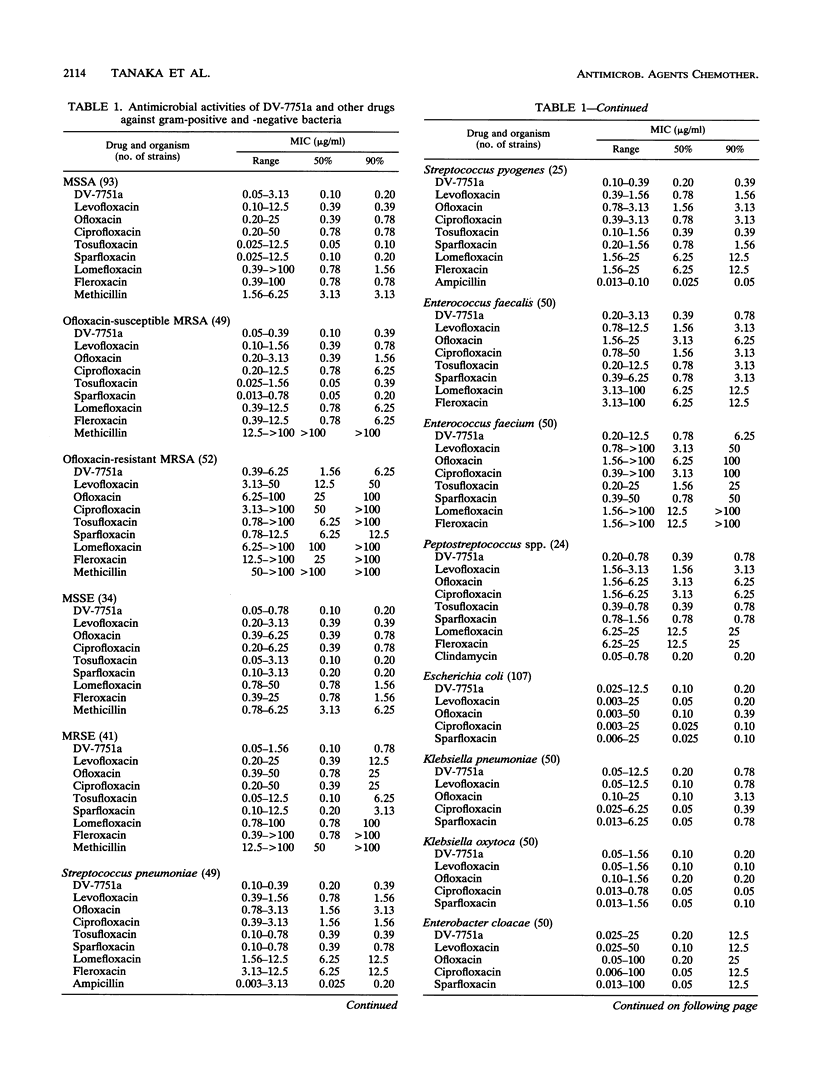
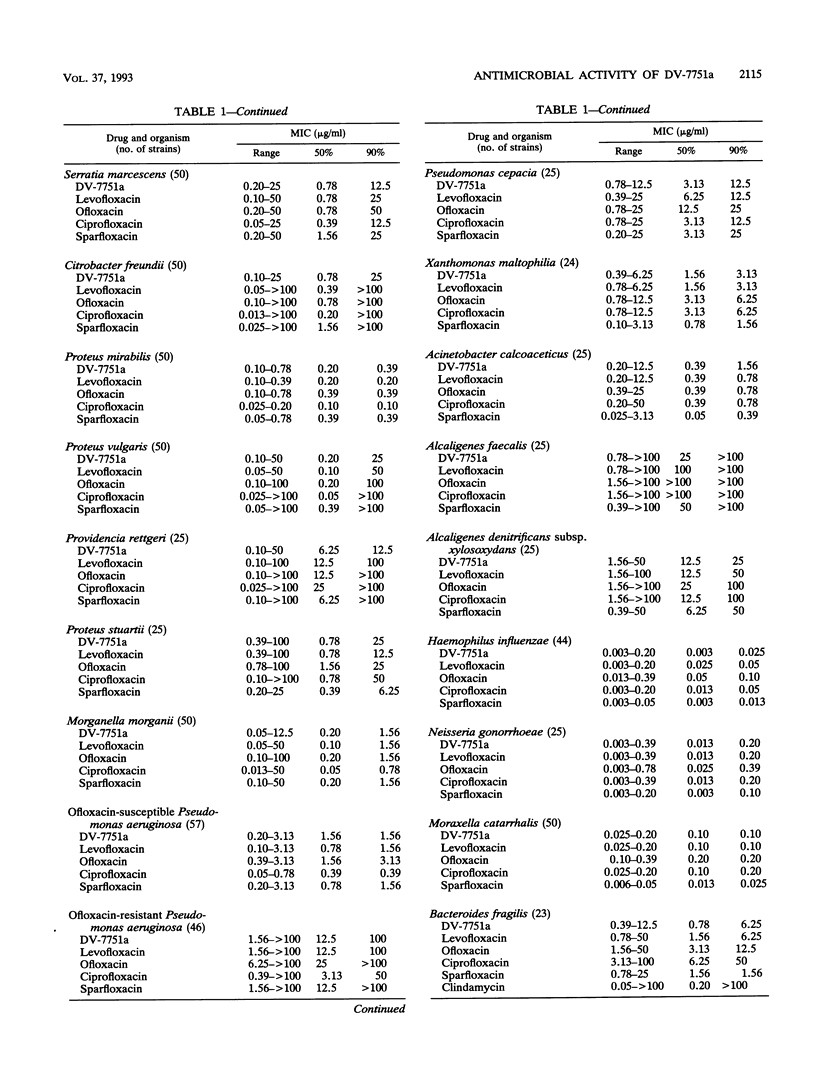
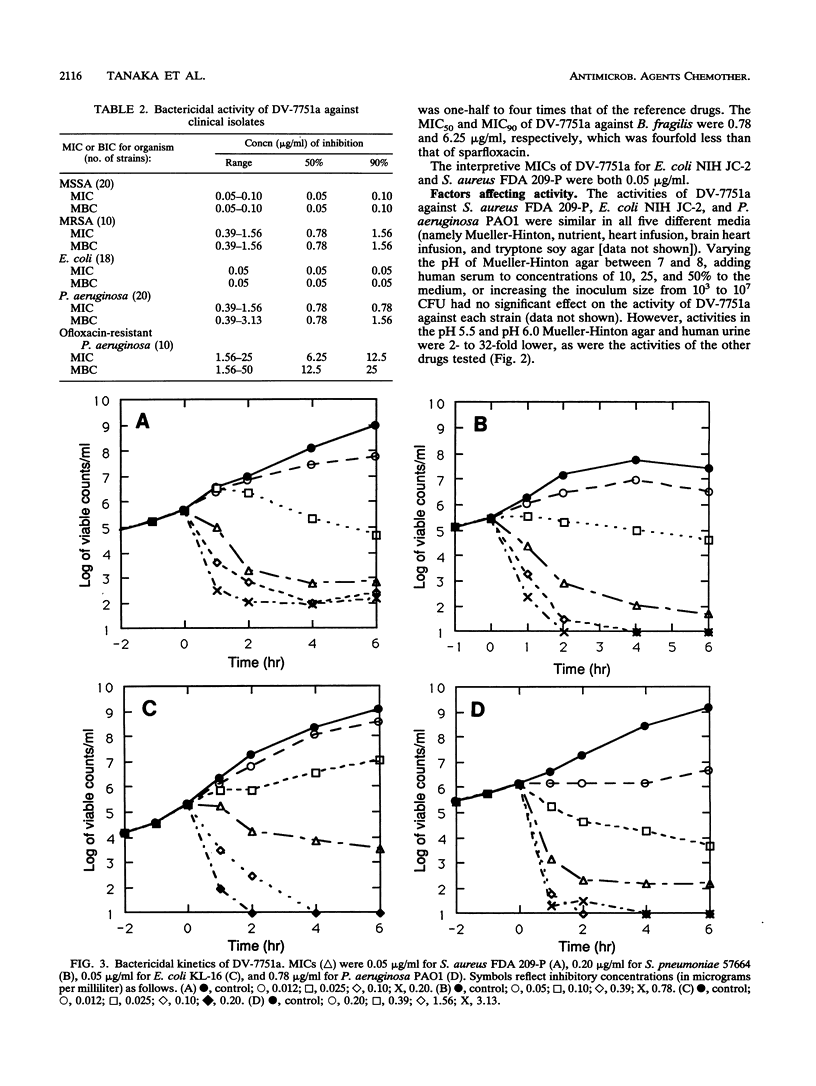
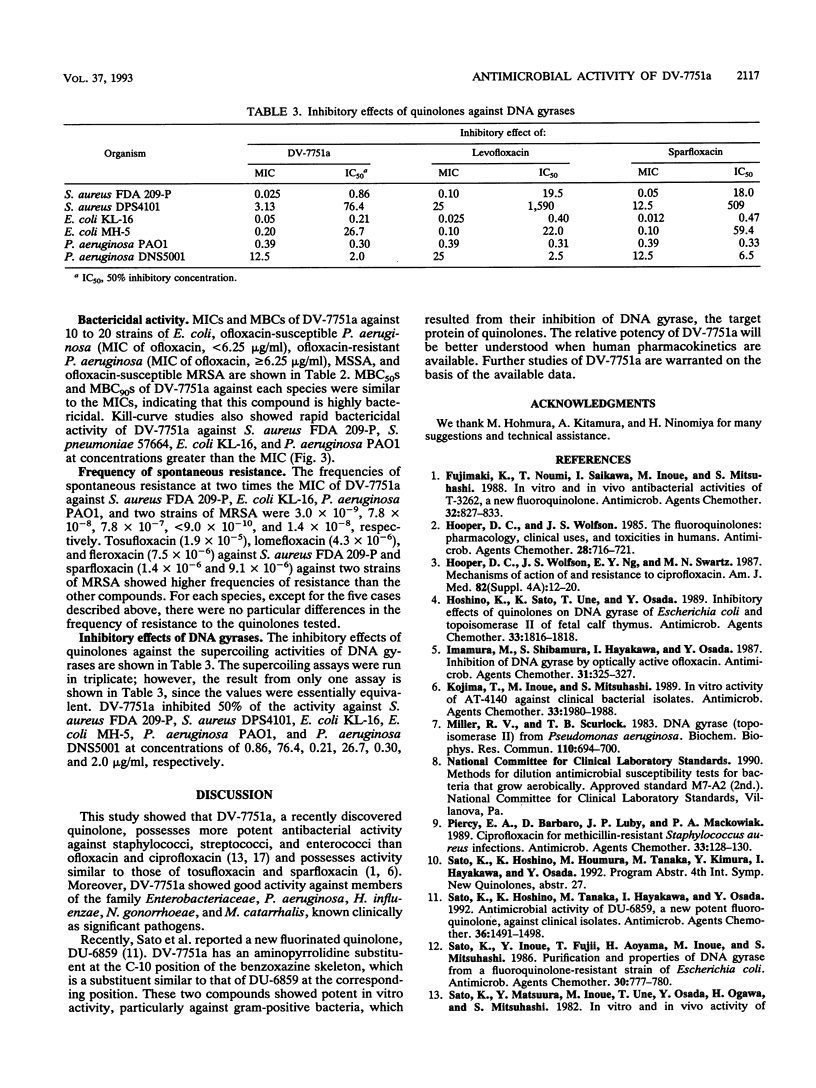
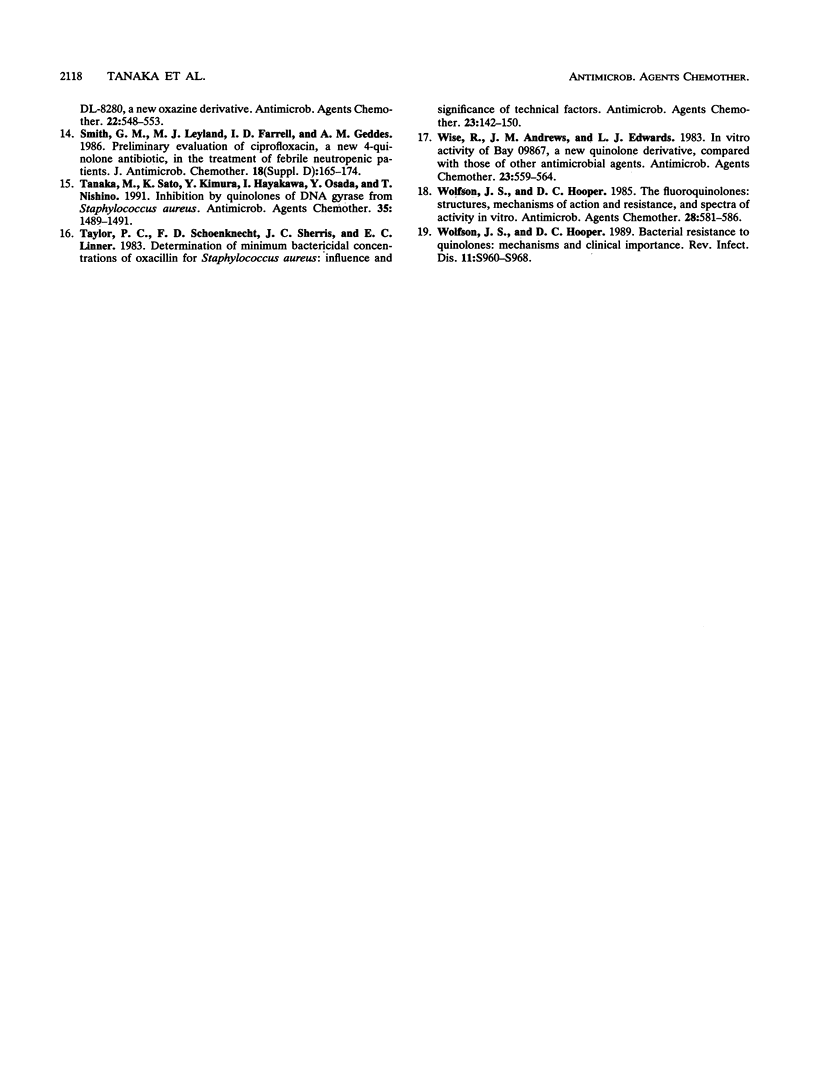
Selected References
These references are in PubMed. This may not be the complete list of references from this article.
- Fujimaki K., Noumi T., Saikawa I., Inoue M., Mitsuhashi S. In vitro and in vivo antibacterial activities of T-3262, a new fluoroquinolone. Antimicrob Agents Chemother. 1988 Jun;32(6):827–833. doi: 10.1128/aac.32.6.827. [DOI] [PMC free article] [PubMed] [Google Scholar]
- Hooper D. C., Wolfson J. S., Ng E. Y., Swartz M. N. Mechanisms of action of and resistance to ciprofloxacin. Am J Med. 1987 Apr 27;82(4A):12–20. [PubMed] [Google Scholar]
- Hooper D. C., Wolfson J. S. The fluoroquinolones: pharmacology, clinical uses, and toxicities in humans. Antimicrob Agents Chemother. 1985 Nov;28(5):716–721. doi: 10.1128/aac.28.5.716. [DOI] [PMC free article] [PubMed] [Google Scholar]
- Hoshino K., Sato K., Une T., Osada Y. Inhibitory effects of quinolones on DNA gyrase of Escherichia coli and topoisomerase II of fetal calf thymus. Antimicrob Agents Chemother. 1989 Oct;33(10):1816–1818. doi: 10.1128/aac.33.10.1816. [DOI] [PMC free article] [PubMed] [Google Scholar]
- Imamura M., Shibamura S., Hayakawa I., Osada Y. Inhibition of DNA gyrase by optically active ofloxacin. Antimicrob Agents Chemother. 1987 Feb;31(2):325–327. doi: 10.1128/aac.31.2.325. [DOI] [PMC free article] [PubMed] [Google Scholar]
- Kojima T., Inoue M., Mitsuhashi S. In vitro activity of AT-4140 against clinical bacterial isolates. Antimicrob Agents Chemother. 1989 Nov;33(11):1980–1988. doi: 10.1128/aac.33.11.1980. [DOI] [PMC free article] [PubMed] [Google Scholar]
- Miller R. V., Scurlock T. R. DNA gyrase (Topoisomerase II) from Pseudomonas aeruginosa. Biochem Biophys Res Commun. 1983 Jan 27;110(2):694–700. doi: 10.1016/0006-291x(83)91205-6. [DOI] [PubMed] [Google Scholar]
- Piercy E. A., Barbaro D., Luby J. P., Mackowiak P. A. Ciprofloxacin for methicillin-resistant Staphylococcus aureus infections. Antimicrob Agents Chemother. 1989 Jan;33(1):128–130. doi: 10.1128/aac.33.1.128. [DOI] [PMC free article] [PubMed] [Google Scholar]
- Sato K., Hoshino K., Tanaka M., Hayakawa I., Osada Y. Antimicrobial activity of DU-6859, a new potent fluoroquinolone, against clinical isolates. Antimicrob Agents Chemother. 1992 Jul;36(7):1491–1498. doi: 10.1128/aac.36.7.1491. [DOI] [PMC free article] [PubMed] [Google Scholar]
- Sato K., Inoue Y., Fujii T., Aoyama H., Inoue M., Mitsuhashi S. Purification and properties of DNA gyrase from a fluoroquinolone-resistant strain of Escherichia coli. Antimicrob Agents Chemother. 1986 Nov;30(5):777–780. doi: 10.1128/aac.30.5.777. [DOI] [PMC free article] [PubMed] [Google Scholar]
- Smith G. M., Leyland M. J., Farrell I. D., Geddes A. M. Preliminary evaluation of ciprofloxacin, a new 4-quinolone antibiotic, in the treatment of febrile neutropenic patients. J Antimicrob Chemother. 1986 Nov;18 (Suppl 500):165–174. doi: 10.1093/jac/18.supplement_d.165. [DOI] [PubMed] [Google Scholar]
- Tanaka M., Sato K., Kimura Y., Hayakawa I., Osada Y., Nishino T. Inhibition by quinolones of DNA gyrase from Staphylococcus aureus. Antimicrob Agents Chemother. 1991 Jul;35(7):1489–1491. doi: 10.1128/aac.35.7.1489. [DOI] [PMC free article] [PubMed] [Google Scholar]
- Taylor P. C., Schoenknecht F. D., Sherris J. C., Linner E. C. Determination of minimum bactericidal concentrations of oxacillin for Staphylococcus aureus: influence and significance of technical factors. Antimicrob Agents Chemother. 1983 Jan;23(1):142–150. doi: 10.1128/aac.23.1.142. [DOI] [PMC free article] [PubMed] [Google Scholar]
- Wise R., Andrews J. M., Edwards L. J. In vitro activity of Bay 09867, a new quinoline derivative, compared with those of other antimicrobial agents. Antimicrob Agents Chemother. 1983 Apr;23(4):559–564. doi: 10.1128/aac.23.4.559. [DOI] [PMC free article] [PubMed] [Google Scholar]
- Wolfson J. S., Hooper D. C. Bacterial resistance to quinolones: mechanisms and clinical importance. Rev Infect Dis. 1989 Jul-Aug;11 (Suppl 5):S960–S968. doi: 10.1093/clinids/11.supplement_5.s960. [DOI] [PubMed] [Google Scholar]
- Wolfson J. S., Hooper D. C. The fluoroquinolones: structures, mechanisms of action and resistance, and spectra of activity in vitro. Antimicrob Agents Chemother. 1985 Oct;28(4):581–586. doi: 10.1128/aac.28.4.581. [DOI] [PMC free article] [PubMed] [Google Scholar]


